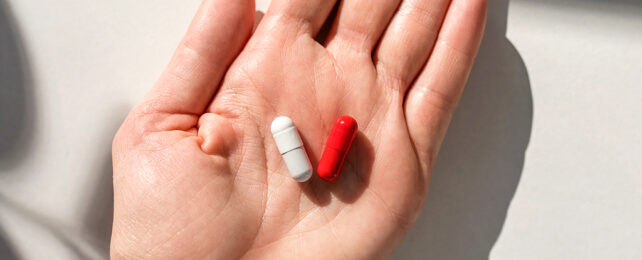Placebos refer to activities or substances that resemble forms of therapy yet have no direct effect on a patient's bodily or brain functions.
They might include swallowing pills made of nothing but sugar, being injected with a saline solution, or using fake instruments, such as sham needles that resemble those used in acupuncture.
A proportion of people receiving a placebo typically report changes in their condition – such as a reduction in pain, a gain in energy or awareness, or general improvement in wellbeing – which can't be attributed to the physical nature of the medication or activity. This is called the placebo effect.
Though the effect can frustrate searches for effective medical treatments, it can be a potentially useful tool for testing pharmaceuticals and other health therapies if used appropriately.
What causes the placebo effect?
It isn't entirely clear why some people experience what's known as the 'placebo effect', though clues might be found in the way seemingly irrelevant differences between similar treatments can deliver different outcomes.
For example, a number of studies have shown the appearance of an inert pill can influence our impression of its effect on the body, acting as stimulants or depressants depending on their color. As can the pill's shape. Its price and how it's marketed can also affect how we perceive its strength. The placebo effect also seems to be stronger today than it has been in the past.
Notably, these impressions can vary depending on cultural backgrounds. White Americans tend to regard white pills as analgesics, for example, while Black Americans view them as stimulants.
Materials associated with pain, such as leaves that resemble those of poison ivy, can produce uncomfortable sensations instead, in what's regarded as the 'nocebo' effect.
Without any conceivable chemical connection between the substance and physiological changes, placebos most likely affect our perceptions of our own health on a psychological level.
In other words, our impression of a treatment – as inherited from our culture – frames how we experience its effects on our body.
This might include a touch of classical conditioning, a psychological phenomenon explaining why we learn to associate a sensation or emotion with a particular stimulus, such as feeling hungry when we hear a lunch bell or anxiety when we smell the disinfectant of a hospital waiting room.
Expectations can also determine how we might pay attention to our body. Undergoing a medical ritual, such as taking a pill daily, could frame our experience of a condition as improving, reducing our focus on pain as a concern – because we're taking steps to treat it – drawing our attention to the relatively comfortable sensations we feel.
Hormonal and neurotransmitter responses might also play a role directly improving wellbeing by raising levels of 'feel good' chemicals when help seems to be at hand. A 2012 study found people with a variation in an enzyme involved in dopamine breakdown also experienced stronger placebo effects, implying a role for reward pathways in the brain.
What can placebos be used for?
The term placebo comes from Latin, meaning 'to please'. It entered medical jargon in the late 18th century, referring to weakened treatments that aimed to satisfy incurable patients without the need to waste full-strength medications.
By the turn of the 19th century, the concept was being applied to controls in medical experiments. In 1799 the British physician John Haygarth compared metallic pointers intended to 'draw out' disease with wooden placebo versions. Should patients be happy with either object, he reasoned, nothing special could be claimed about the expensive metal rods.
Today placebos are still used as comparisons in medical trials to determine the extent to which perceived benefits in study subjects are the result of the experimental therapy, or are simply a quirk of the placebo effect.
The effect itself can also be used to explain why many contemporary and traditional medical rituals and treatments seem to work in spite of lacking bioactive mechanisms.
Similarly, the nocebo effect helps us understand why many people might experience discomfort from a treatment, such as a vaccine, without a clear cause. Just knowing about possible medication side effects can seed negative expectations about how tolerable a treatment is.
Could we use placebos as a form of medicine?
Placebos are generally provided either without patient awareness, or – more generally, in clincial trials – with their consent to randomly receive either a test treatment or a sham version, without knowing which they're receiving.
Legally and ethically speaking, informed consent forms a vital part of the physician-patient relationship. Patient autonomy has become increasingly important across much of the modern world, making it more important than ever that doctors communicate openly and honestly about their patient's tests and treatments.
In recent years researchers have found the placebo effect could still develop in some people even when the recipient knows their treatment has no active ingredients or mechanisms.
This might side-step concerns over informed consent, but introduces new questions over the ethics of administering treatments where the costs, benefits, and mechanisms are still largely unexplored.
When should a patient be administered a sugar pill over a treatment that has a chance of helping improve health and wellbeing? How should this be regulated? How much should a 'fake' pill cost, especially when more expensive placebos tend to be stronger?
Placebo effects are complicated consequences of psychology. Their effect is small, but can be significant in trying to tease apart cause and effect in medicine.
Perhaps most optimistically, they're a tiny, free benefit to any treatment, fake or otherwise.
All Explainers are determined by fact checkers to be correct and relevant at the time of publishing. Text and images may be altered, removed, or added to as an editorial decision to keep information current.
